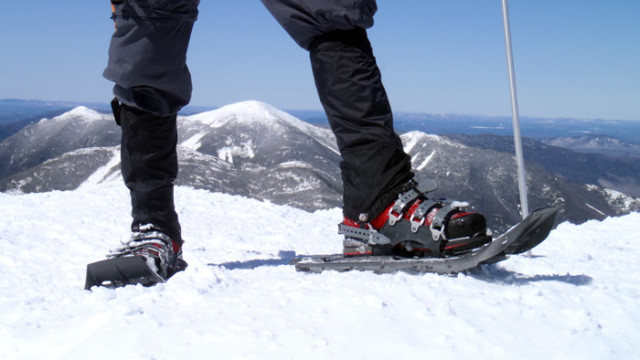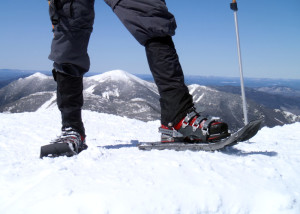
As anyone who’s been playing around in the outdoors for a while knows, there’s no such thing as a perfect boot. To work well, a boot has to 1) fit the user, and 2) fit the intended use. If it falls short in either of those areas, it isn’t a great boot for you, even if it might be the perfect boot for someone else in a different situation.
After a full winter of testing, I’m prepared to say the Lowa Mountain Expert mountaineering boot is close to perfect for my feet and my winter mountaineering needs in the Northeast. That makes them a great boot for me. Perhaps for you, too.
In early December of 2012, I conceived a yen to stand on the highest points of Maine, New Hampshire, Vermont, New York and Massachusetts in the winter. Greylock in Massachusetts is pretty easy, as is Mansfield in Vermont, but Marcy in New York, Katahdin in Maine, and, particularly, Mount Washington in New Hampshire have a nasty habit of killing people who don’t take them seriously, especially in winter. I could make do with mid-weight hiking boots, or rent winter mountaineering boots. But those were far from ideal solutions. I wanted good winter boots that fit me, that I knew I could rely on.
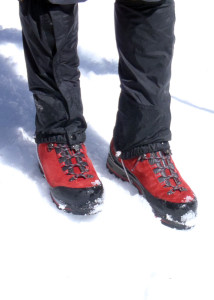
Before selecting any boots I always take a mental inventory of what I’ve tried in the past for the same or similar intended uses. I recommend that you do the same.
Many years ago BG (Before Gore-Tex™), I purchased a pair of stiff-soled leather “mountaineering” single boots, maker unknown, that were heavy (but not as heavy as the double leather mountaineering boots of the time), as comfortable as a stiff-soled boot could be, offered good support, and could handle the crampons available then. They weren’t very warm, got wet in snow, froze overnight, but worked pretty well overall. I took good care of them, had them resoled twice. Eventually, they simply wore out.
In 1980, when I had dreams of summiting as many mountains as I possibly could in my lifetime, I bought a pair of Koflach Ultra double mountaineering boots with an inner leather bootie covered by a plastic shell. While they were extremely warm, waterproof to the point that you couldn’t get moisture in or out, plenty stiff enough for crampons, and the right “size” for me, they didn’t fit my low-volume foot and ankle very well. No matter what sock combination I tried, or how hard I pulled on the laces, there simply wasn’t enough moleskin in the world to prevent blisters. I sold them.
So when and started looking for a pair of boots to do the highest peaks of the northeast, I already had a good idea of what I wanted, a new and improved version of my old leather single boots. My wish list looked like this:
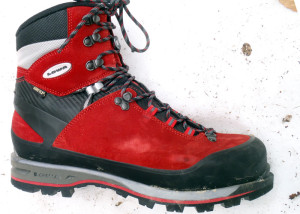
1) Comfortable and lightweight enough for long-distances (Marcy’s summit, for example, is a 15-mile round trip from the nearest road). For me, that meant a low volume single boot with a good heel pocket. Remember, it’s usually easier to slightly expand a boot if it’s tight in spots than to fill up the empty space if you are sliding around inside it.
2) Soles and ankle support stiff enough for crampons and snowshoe on steep terrain, especially sidehills.
3) Warm enough to handle sub-zero temperatures for a full day outing.
4) Waterproof under any normal conditions.
5) Quality construction and long-term durability. Good boots are expensive and a chore to break in; you want them to last.
I also knew exactly what I wanted to do with them: non-technical winter mountaineering and camping, traveling on steep terrain with snowshoes, crampons and other trail traction aids, sometimes with a very heavy pack. I don’t think I’ll be climbing out West anytime soon, but I’ll have them if I want to.
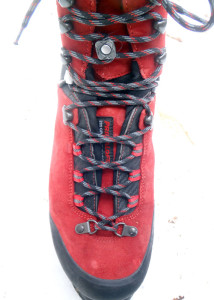
Online catalogs and gear reviews helped me focus in on specific boots. More helpful were visits to several local outdoor shops. But the Lowa brand really snapped into focus with two chance encounters: First, the FREE gear demo program run by the AMC at their Joe Dodge Lodge in Pinkham Notch in New Hampshire’s White Mountains features Lowa boots. I tried them on there and generally liked the fit and feel. Second, EasternSlopes.com’s Senior Editor David Shedd has an older pair of Lowa Baikals (alas, no longer made) which are superb for snowshoeing, and fit my feet like they were made for me.
I called Lowa customer service (1-888-335-5692). VERY helpful people! When I described my foot issues, and how I intended to use the boot, the Mountain Expert came into the discussion right away. I was assured that the Lowa Mountain Expert is made on a low-volume last (they have other, very similar boots lasted for folks with wider feet). I was also told they’d handle some ice climbing–which is pretty high on my bucket list. Bonus!
The nearest store (REI) stocking this boot is two hours away, so I took a chance and ordered them by mail. (Hint, before you try this, get your foot measured on a Brannock device at a shoe store to make sure you are ordering the correct size.) They arrived just before Christmas (Thanks, Brown Santa!).
Construction and fit were flawless on first inspection (and remain so after a number of outings). These boots are built like tanks. On the scale, my Mountain Experts in size 44 Euro weighed in at 4.6 pounds for the pair–quite light for a boot this sturdy and warm.
Usually, boots worn only inside and kept clean can be returned if the size or fit are wrong, so my first try-on was in my living room. Thanks to a new and patented tongue stud and well-thought-out design, the lacing system is superb, allowing you to tighten the lower boot and the ankle/cuff area differently as you need to fit your specific foot. You can see a video of exactly how it works here.
What Lowa calls their “Flexfit Synchro” delivered on its promise to pull the heel back into the heel pocket and allow the ankle to flex forward naturally. The sole was indeed stiff enough to allow easy crampon use and they are compatible with most crampon styles, including the new “step-in” crampons. But pronounced sole rocker made it easy to walk more naturally than you might expect with a sole this stiff.
Usually, when I get a new pair of boots I immediately take out the factory insoles and replace them with high-quality aftermarket insoles such as Zapz, Spenco or Superfeet. No need to do that with these Lowas–the supplied insole provides plenty of cushioning and support.
In all, they fit and felt exactly as described, like a stiffer, beefier version of the Baikals. I wore them around the house for a couple of hours the first day, then longer each day for several days thereafter. I experienced no problems; it was time to take the Mountain Experts to a mountain.
Lowa Mountain Expert Trekking Boots on Icy Monadnock
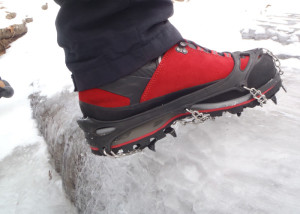
I’ve never seen any hard data to prove it, but Mount Monadnock (3,165 feet) in southwestern New Hampshire is often referred to as the “second most climbed” mountain in the world after Fuji in Japan. I know for a fact it’s the mountain I’ve climbed most. It is a perfect place to break in new boots . . .
My favorite route up is the Dublin Trail, part of the Monadnock-Sunapee Greenway on the north slope of the mountain. On the day after Christmas, I arrived at the trailhead later than I would have liked. Tracks showed that eight or 10 people had climbed the trail since an inch of snow had fallen on Christmas morning. At least five had also come down the same trail.
The lower slopes were easy walking through open hardwoods with just a dusting of light fluffy snow over rocks and leaves. Any good, sturdy hiking boots would have been fine for this part of the trek. The mountaineering boots were definitely overkill. But, once the slopes started getting steeper and spruces started shading the trail, things got more interesting and the mountaineering boots were definitely welcome.
At one point the trail surface abruptly turned to pure ice, looking more like a series of frozen waterfalls than a hiking trail. From there on up, it was almost all ice. Some of the tracks snaked off into the woods where hikers had bushwhacked to avoid the worst ice. But you could also see where they’d slipped and slid.
The snow had been dusted off a trailside log where previous hikers had sat to pull on traction aids. I followed their lead and donned my own. Since I’m testing traction devices for EasternSlopes.com, I put a Kahtoola MICROspike, the original which defined the category, on my right boot. On my left boot, I alternated between a Hillsound Trail Crampon and a Yaktrax XTR Extreme. All these “micro-crampons” are similar; spiked chains underfoot, with a sturdy rubber harness that pulls over your boots quickly and easily. And though there are differences in features and performance characteristics among the three, they all made it infinitely easier to ascend and descend a trail that was treacherous without. I also had a set of Hillsound Trail Crampon Pros with me. These are a much more aggressive crampon with longer spikes, very useful in some circumstances, but not necessary for this hike.
The tracks told the story. Hikers with crampons or micro-crampons simply walked up the trail, struggling only on three or four ice-covered rock scrambles about six-feet high that are a bit of challenge even when the trail is bare and dry. Hikers without traction aids tried to pick safer routes but still slipped and slid with every few steps. I met one young hiker coming down with work boots and no traction devices at all. He’d given up well before reaching the summit. Good decision on his part!
My primary goal for this day was to begin to break in my new boots without breaking my feet. When I started to feel a hot spot on my left heel that wouldn’t go away despite readjusting my sock and retightening the boot, I quit at the junction of the Dublin and Marlborough Trails about a quarter-mile short of the summit. Minor discomfort is to be expected when breaking in new boots. I could have slapped on moleskin from the first-aid kit in my pack and made the summit, but I had already seen the best view away north to the snowcapped summits of the White Mountains and west to the ski areas of southern Vermont, so didn’t see the point of risking a blister.
The trip down took almost as long as the climb up—even with great boots and crampons I had to be careful with each step on the steeper sections. The only bad slip I had all day was 100 yards from my car, crossing a wooden bridge after I’d taken off the micro-crampons and stored them in my pack.
Overall, the Mountain Expert boots performed admirably. I don’t think I’ve ever broken any boots in without developing a hotspot or blister sometime during the process. The stiffer the boots, the more likely a blister, and the fact that I got nothing more than a little hotspot from this initial trek made the boots go up several notches in my estimation.
Lowa Mountain Expert Trekking Boots Going For Greylock
The next mountain on the agenda was Mount Greylock, the highest peak in Massachusetts. At 3,491 feet it’s only a little higher than Monadnock and the trails are similar. But it was nine below zero as I drove through North Adams, MA, and four below when I parked my car at Greylock Glen just west of Adams and met my new friends from Pittsfield, “Sweep” Voll, and Steve McDermott. Perfect weather for climbing, don’t you think? Good test for the warmth of new boots.
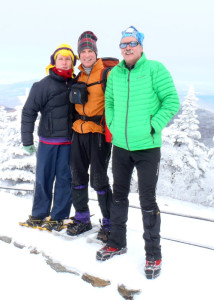
Like many New England mountains, Greylock is kind to you—for a while, at least. The lower slopes are an easy stroll through woods past the remnants of a ski area that never opened, a nice, gentle prelude to the real climb. Our route took us up a variant of the Bellows Pipe Trail to join the Thunderbolt Ski Trail, the most direct route to the top. By the time we actually reached the Thunderbolt, we weren’t noticing the cold at all. In fact, I was stripped to just a lightweight zip-neck shirt with a quilted vest over it.
Once we hit the Thunderbolt, the real climb started . . . you cross a narrow bridge over a stream and immediately head UP. Sections of the trail have names like “Big Schuss,” and “The Steps,” which gives you some indication of how steep they are. The footing was good with either micro-crampons or snowshoes, and, without rushing, we reached the summit a little less than two hours after leaving our cars.
Just shy of the summit, we ducked into the (very cold) stone warming hut to get out of the rising wind, and put on extra layers for the (very cold) stroll to the summit. You haven’t climbed Greylock until you’ve touched the spectacular 92-foot tall Veterans Memorial Tower on top, which was covered in rime ice. At the tower, we bumped into another outdoor friend of Sweep’s, Matt Albert, who had snowshoed up another route. We all shared a cup of hot tea in the warming hut and headed down together.
Again, mountaineering boots could have seemed like overkill for a comparatively small hill like Greylock. But it was really cold, and winter is a time of rapidly changing trail conditions. We all carried both snowshoes and micro-crampons. It hadn’t snowed significantly for several days, and the trail was well packed by earlier traffic. Both the snowshoes and the micro-crampons had their drawbacks at different spots on the mountain. In places where the wind had blown in deeper powder, boots with crampons punched through the packed trail surface. But in other spots, where the wind had blown the snow off leaving ice below, mini-crampons gave us better traction than the snowshoes. Overall, micro-crampons were the better choice.
It was cold enough when we started out that my fingers got really cold even with shell mittens over lightweight gloves. But my toes inside the Mountain Experts stayed toasty. I’d also added a 1/4-inch heel lift under the insoles of the Mountain Experts to fit my heel more tightly into the heel pocket, and had applied pre-cut ENGO Blister Prevention Patches to both boots, and never had the slightest hint of a hotspot or blister.
Marcy Madness: A 15-Mile Day In Lowa Mountain Expert Trekking Boots
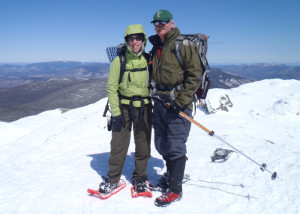
Over the next couple of months, bad weather cancelled a couple of planned attempts on Mount Washington. I did get to use the Mountain Experts several times with snowshoes on hard crust, and was impressed at their stability, particularly on sidehills. If you want to twist an ankle, you are really going to have to work to accomplish it in these boots–even on steep sidehills on snowshoes with a heavy pack.
Several more short trips solidified my overall satisfaction with the boots. While skiing at Wildcat and staying at Joe Dodge Lodge, I took a solo afternoon stroll up to the base of an empty Tuckerman Ravine with a light pack and Hillsound Trail Crampons, a little less than 5 miles round trip and 2,000 or so vertical feet of climbing. I also did an overnight to Black Mountain Cabin on an icy trail, 1.4 miles each way with a 55-pound pack (we don’t ultralight in the winter . . .). On both treks the boots performed perfectly.
Then in late March, I made arrangements to stay two nights at the Adirondack Loj run by the Adirondack Mountain Club, and summit Marcy on snowshoes with two of their very experienced guides, Thea Moruzzi and Julia Goren. Technically, it wasn’t winter: Spring had “officially” begun 10 days before. But the temp was 20 when we started, the wind was blowing straight out of Canada, every step we took was on snow or ice, and there was still over five feet of snow on Marcy’s summit. Argue technicalities all you want, I call that winter.
Climbing Marcy isn’t really difficult, just very l-o-n-g, and therefore a real test of boots. Without any side trips, it’s 7.4 miles from the Adirondack Loj at Heart Lake to the summit. Over that distance you gain 3,164 vertical feet, with only two fairly short, fairly steep sections. Then, of course, you have turn around and come back down 7.4 miles and 3,164 feet . . .
We left the Loj at 7:30 in the morning, and walked the 2.1 miles to Marcy Dam with micro-crampons. I was using the Yaktrax XTR Extreme, which, at 13 oz., are the lightest of the micro-crampons and the least likely to suffer from snow balling up in the cleats on a warm day. Thea and Julia were using proven Kahtoola MICROspikes which worked perfectly as well. Regulations dictate skis or snowshoes when the snow is more than eight inches deep, so at Marcy Dam, we donned small MSR Evo Ascent snowshoes for the climb up and back down. We were back at the Loj by 5:30, about 10 hours after we left.
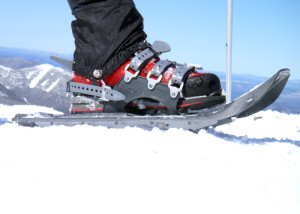
That’s nearly 15 miles of walking in nine hours with 11 miles on snowshoes and four more miles with micro-crampons. The temperature ranged from 20 degrees at the start to nearly 60 in mid-afternoon. We encountered ice, hard crust, corn snow, and slush. My feet were never too warm, never too cold, and never got wet at all. In fact, though the split leather absorbed some water from the wet snow, the boots never got wet inside. The Mountain Experts ventilated moisture so perfectly that the one pair of FITS wool hiking socks I wore all day were almost completely dry at the finish. Moisture management in these boots is impressive, to say the least.
I had one mild hotspot on the outside of my right big toe. It started on the steepest pitches of the down climb but once I re-tightened the boots and the trail leveled off, it never got any worse. The Mountain Expert’s lacing system’s ability to control pressure distribution is truly impressive.
So yes, there’s more testing to do, and the summits of Mount Washington and Katahdin are a different and more dangerous world in the winter than the climbs I’ve done. But based on what I’ve seen so far, I’d have no qualms about attempting either or any of the east’s “big mountains” in any reasonable weather using the Lowa Mountain Experts. So far, they’ve comfortably done everything I’ve asked of them and seem entirely capable of doing even more. That’s my definition of a great boot.


